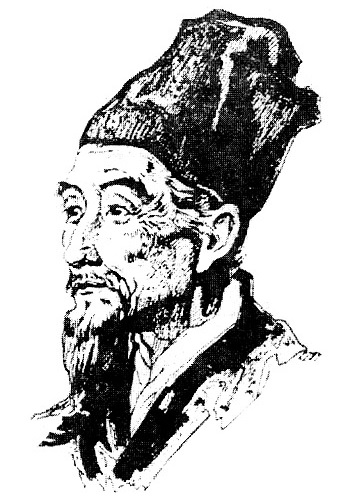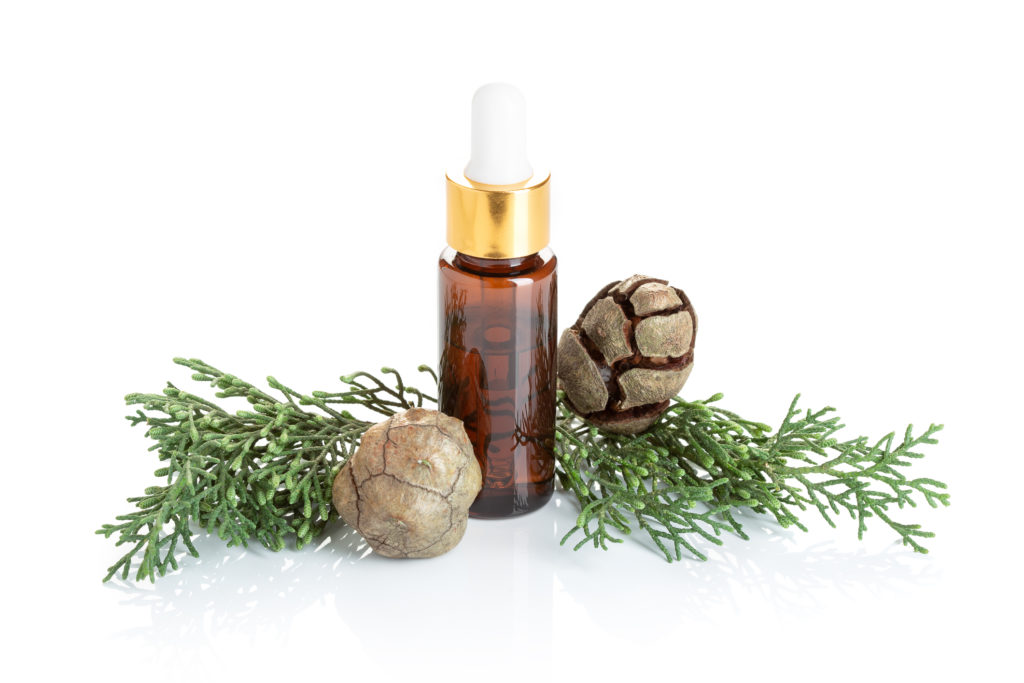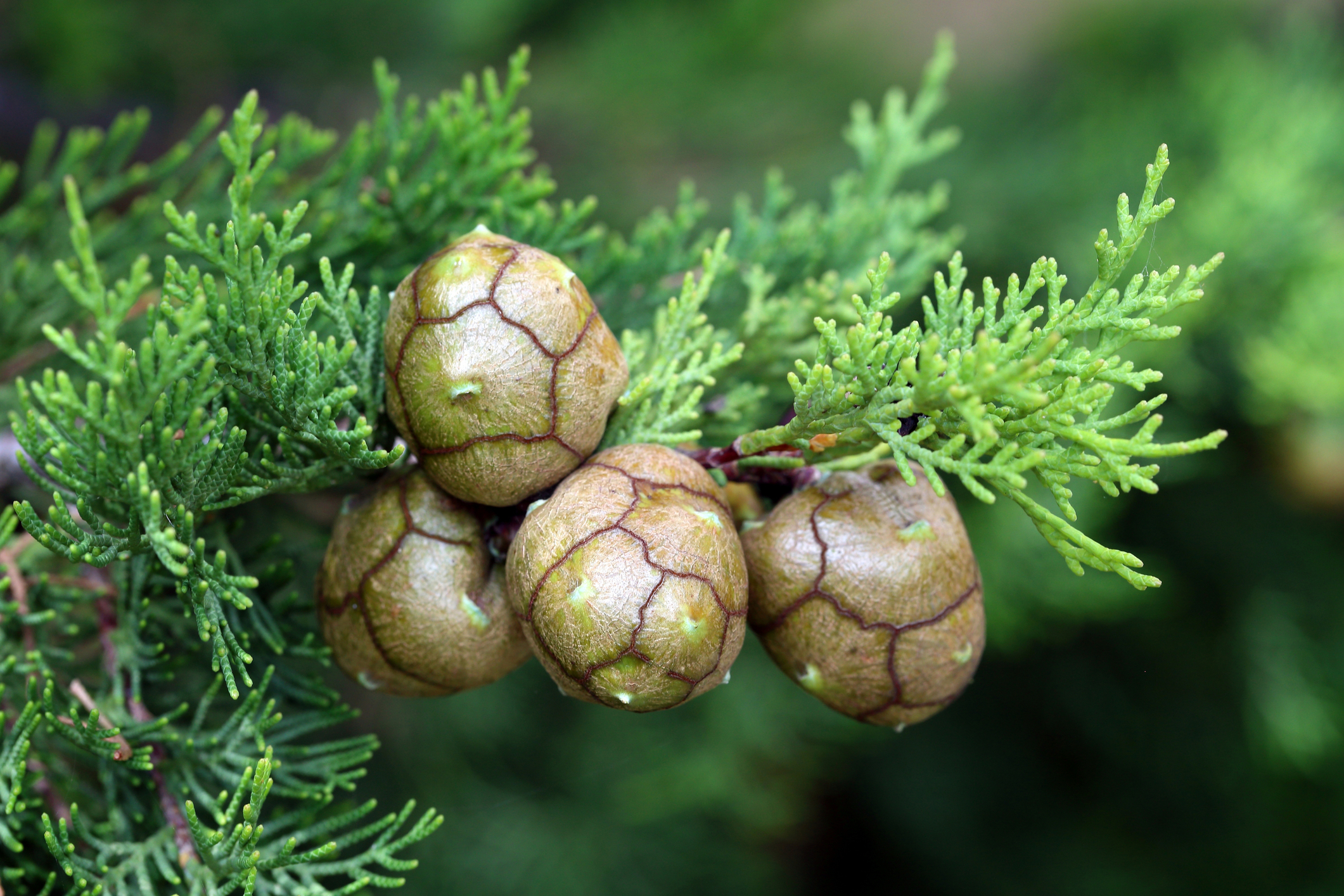With thanks to Tamara Agnew PhD, Petra Ratajc PhD and Marco Valussi BSc for their input
While answering an exam question about deodorant formulation, a student in my Essential Oils for Healthy Skin class listed four books as references. The exam question was about deodorant essential oils, and the oil in question was Cypress. I’m not going to list the particular books cited, as this isn’t really important – and a brief online search shows that Cypress (Cupressus sempervirens) oil as a deodorant is widely quoted, and they all refer to Cypress oil as astringent and/or deodorant. The student passed the exam, but this got me thinking.
 The possible relevance of “astringent” to “deodorant” is that astringency causes tightening of tissues, and so might cause sweat glands to constrict, minimizing the release of perspiration, thus potentially reducing body odor. In fact, this would imply that Cypress oil could act as an “antiperspirant”, which is a particular type of deodorant. (In the USA a “deodorant” is a cosmetic, while an “antiperspirant-deodorant” is both a cosmetic and a drug, and therefore comes under FDA regulations for both.) However, I could find no evidence that Cypress oil – or indeed any other essential oil – has an astringent effect on any tissue. So I decided to use this opportunity as a springboard to explore the issues of correctly citing (and qualifying) evidence, and extrapolation from herbs to essential oils.
The possible relevance of “astringent” to “deodorant” is that astringency causes tightening of tissues, and so might cause sweat glands to constrict, minimizing the release of perspiration, thus potentially reducing body odor. In fact, this would imply that Cypress oil could act as an “antiperspirant”, which is a particular type of deodorant. (In the USA a “deodorant” is a cosmetic, while an “antiperspirant-deodorant” is both a cosmetic and a drug, and therefore comes under FDA regulations for both.) However, I could find no evidence that Cypress oil – or indeed any other essential oil – has an astringent effect on any tissue. So I decided to use this opportunity as a springboard to explore the issues of correctly citing (and qualifying) evidence, and extrapolation from herbs to essential oils.
Deodorant cones, ethnobotany and aromatherapy
A deodorant can be a product with a fragrance that simply masks body odor. For this purpose almost any fragrance, natural or synthetic, could theoretically work, although freshness is usually a desired quality. However, going by this definition, there would be no particular reason to favor Cypress over many other essential oils, and it seems apparent that the word “astringent” is intended to convey a particular effect.
Even if Cypress oil is not astringent or antiperspirant, it could possibly demonstrate a deodorant effect by inhibiting the growth of the bacteria that lead to body odor (Lam et al 2018). One study compared the antimicrobial action of 119 paired essential oil combinations to combat foot odor, targeting the specific bacterial strains associated with this. (The feet have a particular microbiome, so foot odor is a little different to underarm odor, though there is still some correlation.) The findings suggest that Juniperberry (Juniperus virginiana) oil may be the most useful essential oil to use in combination with others for foot odor, while Cypress oil was not especially effective (Orchard et al 2018). Unfortunately, the authors do not give the composition of the Cypress oil used, and from other research, it is apparent that Cypress oil is quite varied in its composition. This partly depends on the relative proportion of leaf and cone material distilled, but overall the antimicrobial activity is not outstanding (Asgary et al 2013, Ben Noury et al 2015, Mahmoud et al 2013, Mazari et al 2010, Selim et al 2014). So while Cypress oil does demonstrate moderate antibacterial activity, the evidence to date does not suggest notable use in deodorants.
It’s absolutely possible that we just need more evidence, but why the claim? The belief that Cypress oil has a deodorant effect most likely derives from the essential oil profiles in two books. In Aromathérapie, by Dr. Jean Valnet (1964), the oil is described as – translated from French – astringent, antisudorific, deodorant (of the feet). In The Art of Aromatherapy, by Robert Tisserand (1977), it is described as astringent, deodorant. So yes, I’m referring to myself the originator of this possible myth in the English language! I pretty much emulated what Valnet had written, but I now believe that he made an inappropriate assumption.
 I also quoted two older sources. In 1578 Shihzhen Li wrote: The nuts are considered to…check profuse perspiration (translated from Mandarin) and in 1652, Nicholas Culpeper wrote: The cones, or nuts…are used in stypic restringent fomentations and cataplasms. But note that these older texts don’t refer to Cypress essential oil, they refer to Cypress cones or nuts. It is possible that Cypress cones do possess astringent properties, as they contain tannins (Al Snafi 2018), a type of polyphenol, and tannins are generally considered to be astringent (De Jesus et al 2012). However, tannins are not volatile, and they are not found in either essential oils or hydrosols. So, some types of extract made from Cypress cones may be astringent, but this would not apply to the essential oil.
I also quoted two older sources. In 1578 Shihzhen Li wrote: The nuts are considered to…check profuse perspiration (translated from Mandarin) and in 1652, Nicholas Culpeper wrote: The cones, or nuts…are used in stypic restringent fomentations and cataplasms. But note that these older texts don’t refer to Cypress essential oil, they refer to Cypress cones or nuts. It is possible that Cypress cones do possess astringent properties, as they contain tannins (Al Snafi 2018), a type of polyphenol, and tannins are generally considered to be astringent (De Jesus et al 2012). However, tannins are not volatile, and they are not found in either essential oils or hydrosols. So, some types of extract made from Cypress cones may be astringent, but this would not apply to the essential oil.
Whether Cypress oil might have an antiperspirant or a deodorant effect is simply not supported by evidence in the essential oil/phytomedicine literature. We are making a considerable, and possibly incorrect leap if we continue to propagate the idea that the same property applies to the essential oil. This confusion between plant extract and essential oil is similar to one I addressed here, concerning Frankincense and cancer.
Citing books as references
The extrapolation issue – from herb to oil – is further compounded by the way information is sometimes used in books. None of the four books I looked at give any evidence for the claimed effect of either astringent or deodorant for Cypress oil. Books are fine as citations, so long as the claim made in the book is itself based on some kind of evidence. The original source of any information should be cited, and the main purpose of citations is so that the reader can verify what is written.
 Unfortunately, authors sometimes copy other authors, presenting unsubstantiated information as fact. (I plead guilty, though it was more than 40 years ago, and I believe I have now learned that lesson!) It is not unusual for herbal books to cite older books. This is fine, so long as author A makes it clear that they are simply repeating what author B wrote, or that they are referring to traditional (ethnobotanical) use of the plant within a certain culture. Basically, the book itself should be able to provide an answer to anyone who asks “Why are you making this claim?” The plot gets lost, however, when the thread is broken, and we see the emergence, for example, of Cypress oil being touted as an astringent as if this was established fact. I am not saying that all evidence has to be in the form of peer-reviewed clinical trials or meta analyses. It could be for example a single case study, or case series, but a statement in a book or blog post does not qualify as evidence, nor does an anecdotal testimonial. See our article about evidence in complementary medicine here.
Unfortunately, authors sometimes copy other authors, presenting unsubstantiated information as fact. (I plead guilty, though it was more than 40 years ago, and I believe I have now learned that lesson!) It is not unusual for herbal books to cite older books. This is fine, so long as author A makes it clear that they are simply repeating what author B wrote, or that they are referring to traditional (ethnobotanical) use of the plant within a certain culture. Basically, the book itself should be able to provide an answer to anyone who asks “Why are you making this claim?” The plot gets lost, however, when the thread is broken, and we see the emergence, for example, of Cypress oil being touted as an astringent as if this was established fact. I am not saying that all evidence has to be in the form of peer-reviewed clinical trials or meta analyses. It could be for example a single case study, or case series, but a statement in a book or blog post does not qualify as evidence, nor does an anecdotal testimonial. See our article about evidence in complementary medicine here.
How to cite evidence
In aromatherapy, as in any remotely academic pursuit, we should be able to cite evidence to support our arguments. Although we are quite restricted when it comes to good essential oil data, this does not mean that we must drop everything – it just means we need to consider where the evidence comes from, and be transparent. For example, you might say: “Authors have previously described Cypress oil as either astringent or deodorant, but there does not appear to be (or I could not find) any evidence that supports this claim.”
 I am not suggesting that we reject or ignore long-standing traditional uses of herbs and plant medicines. But we cannot simply derive our ‘evidence’ about essential oil applications from the practice of herbal medicine, because our product, and the way we apply it, is significantly different. I appreciate that books written for consumers often do not contain references at all, and that this is much more a feature of academic texts. But as far as the aromatherapy community is concerned, I’m just flagging up the idea that claims should be based on transparency and evidence. Of the four texts that I looked at, two are written for consumers, and two for practitioners.
I am not suggesting that we reject or ignore long-standing traditional uses of herbs and plant medicines. But we cannot simply derive our ‘evidence’ about essential oil applications from the practice of herbal medicine, because our product, and the way we apply it, is significantly different. I appreciate that books written for consumers often do not contain references at all, and that this is much more a feature of academic texts. But as far as the aromatherapy community is concerned, I’m just flagging up the idea that claims should be based on transparency and evidence. Of the four texts that I looked at, two are written for consumers, and two for practitioners.
I’m also not saying that Cypress essential oil could not have deodorant or antiperspirant properties, but I’m saying there’s currently no evidence that it does, the little evidence there is suggests it probably doesn’t, and that it’s likely that this claim is based on an erroneous extrapolation from herb to essential oil. But I could be proved wrong in time – again.
References
Al-snafi, A. E. (2016). Medical importance of Cupressus sempervirens – a review. IOSR Journal of Pharmacy 6(6), 66-76
Asgary, S., Naderi, G. A., Shams Ardekani, M. R. et al (2013). Chemical analysis and biological activities of Cupressus sempervirens var. horizontalis essential oils. Pharmaceutical Biology, 51(2), 137–144. https://doi.org/10.3109/13880209.2012.715168
Ben Nouri, A., Dhifi, W., Bellili, S. et al (2015). Chemical composition, antioxidant potential, and antibacterial activity of essential oil cones of Tunisian Cupressus sempervirens. Journal of Chemistry, 2015. https://doi.org/10.1155/2015/538929
Culpeper, N. (1652). The English physitian, or an astro-physical discourse of the vulgar herbs of this nation. Being a compleat method of physick, whereby a man may preserve his body in health, or cure himself, being sick. Peter Cole, London.
De Jesus, N. Z. T., de Souza Falcão, H., Gomes, I. F. et al (2012). Tannins, peptic ulcers and related mechanisms. International Journal of Molecular Sciences, 13(3), 3203–3228. https://doi.org/10.3390/ijms13033203
Lam, T. H., Verzotto, D., Brahma, P. et al (2018). Understanding the microbial basis of body odor in pre-pubescent children and teenagers. Microbiome, 6(1), 1–14. https://doi.org/10.1186/s40168-018-0588-z
Li Shizhen (1558). The grand compendium of materia medica. (Currently published in Mandarin by Chinese Medical Book Press, Beijing.)
Mahmood, Z., Ahmed, I., Saeed, M. U. Q., & Sheikh, M. A. (2013). Investigation of physico-chemical composition and antimicrobial activity of essential oil extracted from lignin-containing Cupressus sempervirens. BioResources, 8(2), 1625–1633. https://doi.org/10.15376/biores.8.2.1625-1633
Mazari, K., Bendimerad, N., Bekhechi, C., & Fernandez, X. (2010). Chemical composition and antimicrobial activity of essential oils isolated from Algerian Juniperus phoenicea L. and Cupressus sempervirens L. Journal of Medicinal Plants Research, 4(10), 959–964. https://doi.org/10.5897/JMPR10.169
Orchard, A., Viljoen, A., & Van Vuuren, S. (2018). Antimicrobial essential oil combinations to combat foot odour. Planta Medica, 84(9–10), 662–673. https://doi.org/10.1055/a-0592-8022
Selim, S. A, Adam, M. E., Hassan, S. M., & Albalawi, A. R. (2014). Chemical composition, antimicrobial and antibiofilm activity of the essential oil and methanol extract of the Mediterranean cypress (Cupressus sempervirens L.). BMC Complementary and Alternative Medicine, 14, 179. https://doi.org/10.1186/1472-6882-14-179
Tisserand, R. (1977). The art of aromatherapy. CW Daniel, Saffron Walden.
Valnet, J. 1964. Aromathérapie. Librairie Maloine, Paris. (English translation: Valnet, J. 1990 The practice of aromatherapy. CW Daniel, Saffron Walden).



Oh, what a myth to debunk. This is a huge one. From day one, I’ve always read, even from clinical aromatherapy text books, that cypress essential oil has deodorizing and astringent properties.
The information you presented is definitely food for thought. Sometimes it’s a bit difficult to navigate the information that’s out there, especially when the actions and properties of an essential oil is usually referenced synonymously to the corresponding herb.
But, as you’ve pointed out, we cannot merely extrapolate the properties of the herb to the essential oil. Great research on your part, per usual.
Thank you for this article, Robert. It is a problem that the authors do not cite their sources and that too often people copy each other without verification. Yesterday I was researching the traditional use of essential oil. I wanted to know if Hildegarde de Bingen used essences. I have not yet read her books (and I am not sure if I am going to read it because I think it is very difficult to read) but I saw on a website this kind of extrapolation to essential oils of the properties of plants Hildegarde used. In my bookshelf I found an author claimed that the saint had recommended to mix a drop of lavender essential oil with an egg yolk for insomnia. Did Hildegade really use essential oils in her time? Perhaps. In any case, there was no reference to Hildegade’s precise text on this point. too often references and sources are missing or are used as a guarantee, a pretext. Your rigour, precision and moderation are a model for me.I thank you for that.
The information in this article Will help me to better discern and question topics being presented as I read through books and articles. Thank you for this.
An enjoyable read thank you